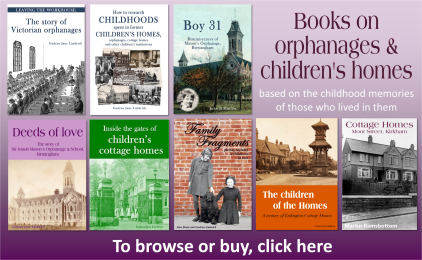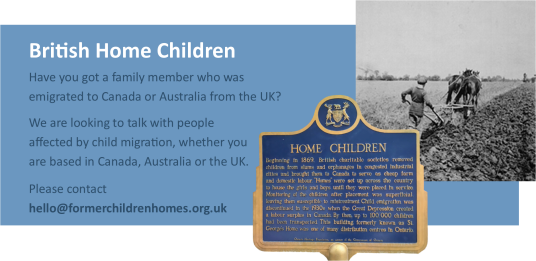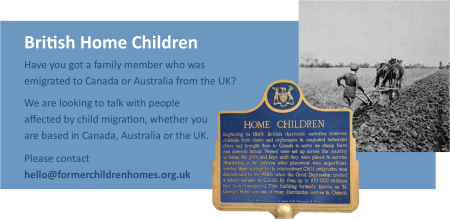OPINION PIECE: Child Migration
Here's the myth - children were plucked from the streets; taken from orphanages and workhouses and put on a ship to Australia or Canada, never to see their families and friends again. Ever.
But wait, that's not a myth! That's not even an exaggeration. It really happened. To thousands of children. And it wasn't so long ago.
It seems like madness but thousands of children were emigrated for more than century. Why were so many children emigrated? Why did it go on for so long? Perhaps I missing something here - perhaps there really is something good to be said about child emigration...
It seems shocking, but in the not-so-distant past, it was decided that the best thing we could offer homeless, parentless or destitute children was to send them to the other side of the world.
Can people really have believed it was ‘the best thing’ for children? Or was it just an easy way of dealing with the challenge of supporting the many poor children in our towns and cities?
The idea, although not a new one, really took hold in Britain in the mid-nineteenth century. While industrialisation had brought families into the towns and cities to find work, many ended up living in poverty and jobless. Hundreds of children were living on the streets, or being taken into orphanages and workhouses.
The New World, on the other hand, had lots of space, lots of fresh air and a need for people to work on the land, clean the houses and so forth.
It was thought a perfect fit – the UK had children needing homes, Canada and Australia needed people.
I would argue that it is only a ‘perfect’ fit if you don’t take into account the feelings and mental health of the people at the heart of this arrangement – the children themselves.
When I first heard about child migration, I couldn’t really believe it was true. Surely it was just a one-off. Or maybe it only affected a few children.
I was wrong. Thousands of children were emigrated during a very dark century in England’s history. I have been able to look at the child migration figures of two organisations - a taster of what was going on.
The first is The Middlemore Emigration Homes, an organisation established by the Birmingham MP, John Middlemore, specifically to migrate children from Birmingham. Their annual reports state that, from the year it started in 1872 to 1924, 5,252 children had been emigrated – chiefly to Canada. That’s 100 children a year through just one organisation in just one city.
The 1873 annual report justified this by saying “It is found that unless these children are once and for all taken away from their early associations, they are apt, even after long training, to return to their first and most familiar haunts and become enemies of society”. In other words, poor children have to be taken as far away from their families and communities, they will become criminals.
In the next 26 years – up to 1950 - a further 3,000 children were emigrated from Middlemore Emigration Homes. This is despite disruption because of the Second World War and the migrations switching from Canada to Australia.
The Emigration Homes began by taken children who were living on the streets. However, their work expanded to emigrating children on behalf of the Poor Law Union and independent reform schools, orphanages and charities.
The other data I found was in the National Children’s Homes annual reports. The National Children’s Home was (and still is) a very respectable large charity and I have to stress that it was not the only well-known charity to be involved in child migration - it was joined in this practice by, for example, Barnardo’s.
According to the 1908-09 annual report “the NCH was one of the earliest institutions to send children to Canada, and we were able to give important assistance to Dr Barnardo when he followed our example”. In their first 40 years 2,207 children - or about 55 children a year - were emigrated from NCH. From the annual reports of the following years, it seems that the average each year decreased over time. Over the next 26 years, an average of 41 children were emigrated each year.
Reading annual reports only tells you so much however so I will share with you this story. I regularly meet people who tell me their memories of being in a children’s home or orphanage. On one occasion, I met John (this is not his real name) who told me a story that I now understand to be not uncommon, although absolutely tragic. John was in an orphanage. When he went into the orphanage, he was with his sister but, after a short time, she was sent somewhere else. One day, out of the blue, he received a postcard from her. In the card she said that she was had been taken on holiday and was on a sea journey. While she sounded happy and excited, John had a bad feeling about it. Sometime later, he had another postcard – from Australia. She still sounded happy and she said she couldn’t wait to see him to tell him all about her holiday. Of course, it wasn’t a holiday. John and his sister never saw each other again.
"The poor are no better and no
worse than ourselves. There is
splendid stuff in them - especially
when they are young. It is the
nation's plain duty to bring the
landless children of one part of the Empire to the comparatively
unoccupied land of the other"
Kingsley Fairbridge
Child Immigration Society, Australia
This terrible event didn’t happen a very long time ago – it was only in the 1940s. For John, it is still fresh in his mind.
The awful practice of child migration did not stay in the nineteenth century, it carried on into the 1920s, 1930s, 1940s and I have heard that it went on in some places in the 1950s and 1960s.
Boys were mostly sent into farm work, girls into domestic service. For some, they were able to find good families to live with and good jobs in developing local communities. For others, however, we know now that they were mistreated and went into miserable situations.
It must have been incredibly painful for those children who found themselves uprooted in this way, and for their friends and families left behind, but the pain did not end there.
Travelling between Australia and Canada was very expensive. Once a child was sent overseas, it was unlikely many would have been able to afford to travel back to England, either to move back or to visit family for a holiday. Even now, prices mean that flights are out of the reach of many. This can leave former migrants unable to visit their families, even if they are able to trace them.
I always try to view what has happened in the past in the way that those people living then would have viewed it and to try to see it objectively. However, whichever way I look at child migration, all I see is a cruel practice, the impact of which is still being felt by individuals and families today.
Gudrun Limbrick
For more information on Middlemore Emigration Homes, please see our page here.
A Positive Result
A family story sent in by Dick:
"I read with interest your comments about the Middlemore home in Birmingham and the practice of sending poor children abroad.
I offer the following story about my grandfather Harry Clarke.
"He was the oldest child and only son in a family with eight sisters living in a back-to-back. At age 13 he became truant from school, stayed out at night, and got into petty crime. HIs father applied to the Middlemore home and Harry was accepted for emigration. After a half year of training, he was sent to a farm in New Brunswick, Canada.in 1891. After 6 years on the farm, Harry worked on a cattle boat to get back to Birmingham. He convinced his parents and five of his sisters to emigrate to Canada which they did in 1902.
"Harry had good things to say about his time as a 'home child' in New Brunswick and the first thing he did upon returning was to visit the farmer. He then moved west to Alberta where homestead land was available and he and his parents and siblings had successful lives in Alberta.
"This is one case where child emigration had a positive result and I am sure there are many others. Certainly as you point out many had unhappy experiences."









